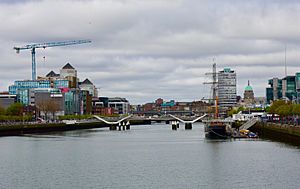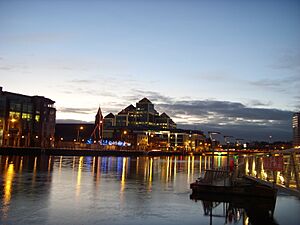Economy of Dublin facts for kids
Dublin is the biggest city and the capital of Ireland. It's like the main engine for Ireland's economy. This means it's where a lot of important business and money-making activities happen.
The national parliament, called the Oireachtas, is in Dublin. Many government offices are also located here. Dublin is also the main place for news and media in Ireland. Most of the country's roads and railways start from Dublin. Dublin Port is a very busy port, handling a lot of goods that come into and leave Ireland.
Many large international companies have offices in Dublin. These include "hi-tech" businesses like those in information technology, digital media, financial services, and the pharmaceutical industry (making medicines). Big Irish companies like Bank of Ireland and Ryanair also have their main offices in Dublin. Plus, many public services, like universities and hospitals, are based here.
Contents
Getting Around Dublin
Dublin is a major hub for travel in Ireland.
Canals and Ports
Ireland has two long canals, the Royal Canal and the Grand Canal. They both meet near Dublin Bay. The country's railway system also starts from Dublin. Many main roads spread out from the city too. Dublin Port is the largest port in Ireland, handling a huge amount of goods.
Dublin Airport
Dublin Airport is the biggest and busiest airport in Ireland. It has two terminals and handles almost 33 million passengers each year (as of 2019). Big Irish airlines like Aer Lingus and Ryanair have their main offices in Dublin.
Trains and Trams
The two main train stations in Dublin are Heuston and Connolly. From these stations, trains go all over the Greater Dublin Area and to nearby towns.
The Dublin Area Rapid Transit (DART) is an electric train line. It runs mostly along the coast from Malahide and Howth in the north, all the way south to Greystones. In 2016, nearly 19 million people used the DART!
The Luas is an electric tram system that started in 2004. It carried over 34 million passengers in 2016. There are two main Luas lines:
- The Red Line connects the city centre and the Docklands with the south-western suburbs.
- The Green Line links the city centre with suburbs in the south.
Dublin's Key Industries
In mid-2017, about 874,400 people worked in the Greater Dublin Area. This area includes counties Meath, Kildare, and Wicklow. About 60% of people working in Ireland's finance, technology, and professional services are in this area.
Media and Communication
Dublin is home to many national newspapers, radio stations, and TV channels. RTÉ is Ireland's national public broadcaster, based in Donnybrook. Other TV channels like Virgin Media One are also in the city.
The main offices for Ireland's postal service, An Post, are in Dublin. Big phone companies like Eir, Vodafone, and 3 are also located here. National newspapers like The Irish Times and Irish Independent are based in Dublin too.
Food and Drink
One of Ireland's most famous drinks, Guinness, has been brewed at the St. James's Gate Brewery in Dublin since 1759. The city also played a big part in the beef industry.
Technology and Internet
Many big technology companies have offices in Dublin. These include Amazon, eBay, Facebook, Google, Microsoft, Oracle, PayPal, and Twitter. A special area in the city called Silicon Docks is home to many of these companies.
The area around Dublin also has many large data centers. These are huge buildings that store information for companies like Google, Microsoft, and Amazon. Companies involved in "cloud computing" (which means storing data online) like Dropbox and Salesforce are also here.
Money and Finance
Dublin is an important place for financial services. In 2017 and 2018, Dublin was ranked among the top financial centers in Europe and globally. Many jobs in this area are at the International Financial Services Centre in the Dublin Docklands. The Irish Stock Exchange (ISEQ) is also located in Dublin.
Shopping
Ireland's largest shopping centers are in the Dublin area. These include Dundrum Town Centre (with 160 stores) and Blanchardstown Centre (with 180 stores). In the city center, popular shopping streets are Henry Street and Grafton Street. A report in 2013 showed that Dublin is the main place for shopping in Ireland. It has 25% of the country's shops and about half of all jobs in the retail sector.
Tourism
Many of Ireland's most visited tourist spots are in Dublin. These include the Guinness Storehouse (nearly 1.8 million visitors in 2017), Dublin Zoo (1.2 million visitors in 2017), and the National Gallery of Ireland (over 1 million visitors). In 2016, Dublin welcomed over 5.6 million visitors from other countries. This brought in over €1.9 billion for the city!
Learning and Education
Higher education (universities and colleges) added €10.6 billion to Ireland's economy in 2011. Almost €1 billion of this came from international students. About 57% of these international students study in the Dublin area.
Dublin is a big university city. It has some of the largest and oldest universities in Ireland. These include University College Dublin (UCD), which is the largest, and Trinity College Dublin, one of the oldest. A study in 2014 found that Dublin's three main universities (Dublin City University, Trinity College, and UCD) had a huge positive impact on the country's economy.



